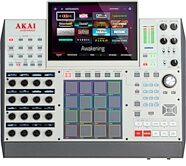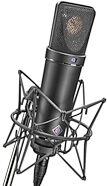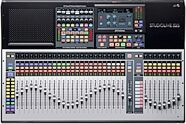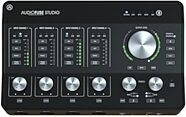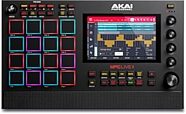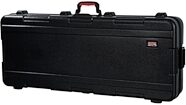
Korg KROSS 2 Keyboard Synthesizer Workstation, 61-Key
A cross between a performance synth and a production workstation, the 61-key Korg KROSS 2 fits 1075 gig-ready presets and a sequencer into a 9-pound package.
$929.99
- 12 x$77.50
- 8 x$116.25
- No Credit Check6 x$155.00
- No Credit Check4 x$232.50
Korg PS60 61-Key Performance Synthesizer
No longer available at zZounds


Fuel your on-stage creativity with Korg's Enhanced Definition Synthesis technology and the natural feel of semi-weighted keys.
Overview
Designed for the gigging - or soon to be gigging - musician, the affordable Korg PS60 delivers premium sounds and professional effects in an easy-to-use package. Heavy on hardware, the PS60's dedicated performance controls keep all the needs of the performer close at hand.
- 440 impeccably voiced, ready-to-play, sounds created by Korg's renowned programmers
- Korg's EDS-i (Enhanced Definition Synthesis - integrated) sound technology
- Create and save up to 20 split and layered "Performances"- on the fly!
- Intuitive front panel layout with dedicated hardware controllers for frequently-used functions
- Nine dedicated knobs provide live control of the master modulation, reverb/delay, and EQ effects
- Free editing software allows the PS60 to run as a plug-in with your host DAW (AU, VST or RTAS)
- Great-feeling, responsive, semi-weighted 61-key Natural Touch keyboard
Any of 63 effects - including dynamics-type effects and amp modeling powered by KORG's proprietary REMS technology - can be assigned to individual sounds using one of the five insert effects. In addition, two master effects can be applied to the overall sound: a modulation-style effect offering four effect types; and a reverb/delay effect also with four effect types. A dedicated three-band EQ adds the final touch to your sound.
*when calculated as 16-bit linear data
You can also choose to split or layer multiple sounds on the keyboard. These settings are collectively called a "Performance," and you can store 20 of them in internal memory. The Performance area to the left side of the panel is used for deeper editing as well as for recalling these Performance settings quickly and easily - even when on stage!
Power Supply:DC 9V 1700mA (Included) read less
Features:
- Instant access to six essential sound categories - Piano, E-Piano, Organ, Strings, Brass, and Synth- 440 impeccably voiced, ready-to-play, sounds created by Korg's renowned programmers
- Korg's EDS-i (Enhanced Definition Synthesis - integrated) sound technology
- Create and save up to 20 split and layered "Performances"- on the fly!
- Intuitive front panel layout with dedicated hardware controllers for frequently-used functions
- Nine dedicated knobs provide live control of the master modulation, reverb/delay, and EQ effects
- Free editing software allows the PS60 to run as a plug-in with your host DAW (AU, VST or RTAS)
- Great-feeling, responsive, semi-weighted 61-key Natural Touch keyboard
A performance synthesizer like no other
In designing the PS60, the needs of the on-stage musician remained front and center. Offering dedicated controls, an ample backlit display, and remarkable ease of use, the PS60 is a refreshing change. The intuitive, realtime controls - even the sounds themselves - were created with the performer in mind, and have been optimized for the unique challenges and immediacy of playing live. Lightweight, stylish and portable, the PS60 travels comfortably from home,… read more to rehearsal, to center stage. The portability, ease of use, and hands-on interface make the PS60 the ideal instrument for the vocalist, guitarist, bass player, sax player - anyone who wishes to cover a few keyboard parts while expanding their audio arsenal.The in-demand sounds every keyboardist requires
Focused on the elemental sounds that make up the body of great keyboard playing, the PS60 delivers 440 spectacular, spot-on sounds - with room for plenty more! The sounds are organized into six categories - piano, electric piano, organ, strings, brass and synth - each with dedicated controls making it easy to find just the right sound. Still not sure? The Audition feature plays a quick riff appropriate to the selected sound, allowing you to hear the sound in context and to help you zero in on the one you want. Using the category controls, you can layer up to six sounds, or make split settings at the touch of a button, creating sophisticated blends to suit your performances.Rippling with synth power
For sound creation, the PS60 uses 49 MB* of the highest quality, 48 kHz samples. The EDS-i sound engine (Enhanced Definition Synthesis - integrated) provides up to four filters, two amps, five LFOs, and five EGs, used to craft a rich array of stage-ready programs that will both complement and stand out in your band's performance.Any of 63 effects - including dynamics-type effects and amp modeling powered by KORG's proprietary REMS technology - can be assigned to individual sounds using one of the five insert effects. In addition, two master effects can be applied to the overall sound: a modulation-style effect offering four effect types; and a reverb/delay effect also with four effect types. A dedicated three-band EQ adds the final touch to your sound.
*when calculated as 16-bit linear data
Easy Setup and Performance control
The PS60 is easy to use. The center and right portions of the panel are primarily for customizing and controlling sounds. Simply use the dedicated Category controls to choose your sounds, and use the Easy Setup area to specify their volume, octave, and effect send amounts. Dedicated panel knobs are provided for tweaking the effects and the EQ.You can also choose to split or layer multiple sounds on the keyboard. These settings are collectively called a "Performance," and you can store 20 of them in internal memory. The Performance area to the left side of the panel is used for deeper editing as well as for recalling these Performance settings quickly and easily - even when on stage!
Command and control
The PS60 provides a variety of controllers to make your performance more expressive. You can produce subtle or drastic pitch and timbral changes by moving the joystick up/down/left/right, and use the octave up/down buttons and transpose buttons to shift the pitch of the keyboard. Two footpedal jacks are provided for use with a damper pedal, footswitch or footpedal, offering hands-free control. When playing organ sounds, an additional dedicated button can switch between fast/slow speeds of the rotary speaker simulator.Keys to please
The PS60 features a richly-expressive keyboard. The semi-weighted, natural-touch keys provide an uncompromising playing feel. Accomplished and would-be keyboardists alike will find the keyboard ready for anything from a piano performance to delivering sizzling synthesizer sounds.Hardware / Software symbiosis
The stand-alone PS60 Editor allows you to edit sounds in greater detail than is possible from the PS60 itself. Viewing multiple parameters and graphical cues on your computer's screen makes it easy to create full-fledged sounds in any category. The PS60 Plug-In Editor offers all the same features, and lets you use your PS60 as a plug-in synth from within any VST, Audio Units, or RTAS format DAW software system. As a librarian program, the software lets you build up an enormous stash of sounds that you've created on your computer.Power Supply:DC 9V 1700mA (Included) read less
Specs
Keyboard: 61-key natural touch keyboard; Velocity sensing
Synthesis: EDS-i (Enhanced Definition Synthesis - integrated)
Polyphony: 120 voices (120 oscillators) max, single mode; 60 voices (60 oscillators) max, double mode
PCM: 49 MB (when calculated as 16-bit linear data), 136 multisamples (including 7 stereo)
Master Keyboard functionality: Allows control of external MIDI devices
Effects types: Total of 71 types
Modulation: Dynamic modulation, tempo sync delay, LFO
Controllers: Joystick
Audio Outputs: Output, L/Mono, R: 6.3 mm monaural phone jack (unbalanced),
Control Inputs: Damper/Pedal/SW jack x 1(half-damper supported); PEDAL/SW jack x 1
MIDI: In, Out
USB: 1 USB (Type B), USB-MIDI interface
Dimensions (W x D x H): 36.41 x 11.45 x 3.54 in.
Weight: 10.14 lbs
Power Supply:DC 9V 1700mA (Included)
Synthesis: EDS-i (Enhanced Definition Synthesis - integrated)
Polyphony: 120 voices (120 oscillators) max, single mode; 60 voices (60 oscillators) max, double mode
PCM: 49 MB (when calculated as 16-bit linear data), 136 multisamples (including 7 stereo)
Master Keyboard functionality: Allows control of external MIDI devices
Effects types: Total of 71 types
Modulation: Dynamic modulation, tempo sync delay, LFO
Controllers: Joystick
Audio Outputs: Output, L/Mono, R: 6.3 mm monaural phone jack (unbalanced),
Control Inputs: Damper/Pedal/SW jack x 1(half-damper supported); PEDAL/SW jack x 1
MIDI: In, Out
USB: 1 USB (Type B), USB-MIDI interface
Dimensions (W x D x H): 36.41 x 11.45 x 3.54 in.
Weight: 10.14 lbs
Power Supply:DC 9V 1700mA (Included)
Documents and Manuals
For support or warranty questions, please contact the manufacturer:
Phone: 631-390-6800
Web: https://www.korgusa.com/support
Phone: 631-390-6800
Web: https://www.korgusa.com/support
Reviews
Reviewers gave this product an overall rating of 4 out of 5 stars.
(10 ratings)
Submitted March 21, 2013 by Wayne K in Friendswood, TX
"Overall a good keyboard"
Verified Customer
zZounds has verified that this reviewer made a purchase from us.
Korg PS-60 First impressions:Layout:I think it's a good looking keyboard. Nothing flashy, but I don't like flashy so that works out well for me. I think all the buttons and knobs are useful and well placed. Very functional board. I cannot overstate this....I absolutely LOVE that it has dedicated Octave and Transpose buttons right on the panel. Every midi controller I've owned has had this, so I've gotten used to it. But I've never seen a synth that had it, not even the fancy ones. So that was a nice addition. My go-to sound for playing on the worship team is a mix of acoustic piano and pad. When using Reason and a controller, I had a combinator I created with an NNXT grand piano, and a Maelstrom Pad, and a Thor Pad, and an NNXT acoustic guitar, and a Rhodes of some sort. And in the combinator each of those instruments went to the small rack mixer. My keyboard would trigger all the instruments at once, and I would assign the mixer faders to my controller's 9 faders. So I could just fade instruments in and out as needed during a performance. The PS60 is layed out in a very similar fashion to this, which is probably why I was so drawn to it. It has 6 sections or categories, and each has an "enable" button, up/down selection buttons, and a knob which can be used for volume or other things. So right off the bat I felt right at home on this board. Also this board has the Korg joystick for modulation/pitch bending, and I really have always wanted a board with this. Watching others use…
read more
them, they just seem more expressive than using the 2 wheels. Acoustic Pianos:The PS60 has 29 acoustic pianos, but #1 on the preset is definitely the best, in my opinion anyway. But it still isn't quite up to what I like. It's a little too bright or something, but then the others are a little too dull. So the best piano on this board is adequate but nothing really special, at least in my opinion. I like the NNXT grand piano I have been using much better than any piano on this board, which is disappointing. The pianos on the Korg X50 I used to have were much better. Pads: I didn't try them all, but of the ones I did try, I really liked them. There were evolving pads, that built up the longer they were sustained. Others were glitchy and cool. Others were warm and inspiring. The pads were in the synth section, which is the farthest away from the piano section. So I have to really stretch to press both the piano enable and the synth enable buttons together. So I didn't care for that. But for others that might not matter. Electric pianos:I have never been a huge electric piano player, but I did give them a listen, and they sounded as good as any I've heard. There is a button that changes the rotary simulator speed on organs with rotary fx. Organs: To me organs and electric pianos kinda fall into the same category, but this board separates them. I'm not a huge organ fan, so I don't have much to say about this either. They sounded good to me. I'll leave the Brass section blank, since I didn't mess with that at all. Violins:I found some nice sounds there. I didn't listen to the solo instruments, but the symphony sounds were nice and full. Keybed:I am not a big fan of a synth (unweighted) key action, but I have to say this one is not bad at all. The keys feel nice to me, and I had no problem playing expressive piano styles on these keys. They seem to respond well to velocity changes, and they are very quiet as well. I hate noisy keys (cough, cough, Juno-Di/Gi, cough, cough), and these are not. Misc:It has a 3.5mm headphone jack on the front left side, which is a nice touch, in my opinion. Some reviews gripe and complain because it's not 1/4", as if that makes any difference in sound or anything else. They say professional headphones are always 1/4". To that I say, my Shure SRH-440's to me are professional enough, and they have 3.5mm plug, with an included 1/4" adapter. There's just no pleasing some people. :-)I like the Midi I/O on the back. I will definitely be utilizing them. There is an editor program you run on your computer that gives you much more control over editing sounds. I haven't tried it out. But I hear it's good. And I can imagine with the small screen on the board you wouldn't want to do much sound-crafting on that. But I'm a preset user anyway, so I doubt I'll mess around much with that. I may tweak a preset a little to my liking, but I never create sounds from scratch. But I think the editor software will allow for that, for those who do that sort of thing. Minor gripes:If I have the piano and pad enabled, and I am holding out a note, and the next song I want to drop the pad, so while I'm holding the chord, you would think I could just push the piano button and it would drop the pad. Well it does, and the chord does continue as expected, however, there is a glitch in the sound when enabling or disabling the various categories. WHAT??? REALLY KORG??? You can't make that a smooth transition???? REALLY???? I mean I guess if I want o drop the pad without having a noticable jolt in sound, I could just fade it out with the volume knob for that category. But I shouldn't have to. That is ridiculous. Changing sounds on a bank also glitches the same way. That is just terrible to me. Sorry for making such a big deal about it, but I really think it would've been so easy to solve the problem, but they didn't do it. Like I said there is a work around, I can use the volume knob, but again I shouldn't have to. I would expect that on a kid's toy piano, but not on one like this. Another thing people complain about is the small amount of preset slots available for saving custom presets. I think there are 20. To me that is more than enough considering each preset has 6 categories that can be turned on or off easily. Neat feature:You can set different categories at different octaves, which I thought was cool. Because I like to play the piano at -1 octave on a 61-key board, because I like the lower sound, but the pad sounded better at 0 octave. I could easily make that change and then save it as a preset. Some people have said that this board doesn't have a combi mode. But I would argue that combi mode is the only mode it does have. It's always in combi mode. It's always got those 6 layers going, whether you're using them or not. I don't use keyboard splits much but setting them up on this board is a piece of cake, and can be done really quickly. And I want to say that on each side of the split you can have any of the 6 voices going at once. So if you have 6 on the left side, you could have 6 different ones on the right side, for a 12 voice combi. Why would you want to do that? I don't know. But you could. Final thoughts:I didn't expect Kronos quality out of a $600 keyboard. I wanted a small lightweight keyboard, with some good bread-n-butter sounds. With a good key action, and really useful buttons and control layouts. I wanted a mod/pitch joystick. And I wanted octave/transpose buttons. And let me just say, that is a lot to ask for $600. I got all of that. The glitchy transitions are a bummer, but like I said, I have an easy work around for that. The only thing I'm truly disappointed about is the poor acoustic piano sounds. But maybe I can tweak those a little. It was too bright, so I could play around with the EQ section maybe. Overall I'm happy with my purchase, and I think this board will do what I bought it for quite well. It's a good board, but with a better piano sound, and smoother transitions it would've been a great board.
Musical Background:
Play every week at church in contemporary worship band.
Musical Style:
Contemporary Christian read less
Musical Background:
Play every week at church in contemporary worship band.
Musical Style:
Contemporary Christian read less
6 of 6 people (100%) people found this review helpful. Did you?
Thanks for your opinion!
No longer available at zZounds
This is a carousel with product cards. Use the previous and next buttons to navigate.



